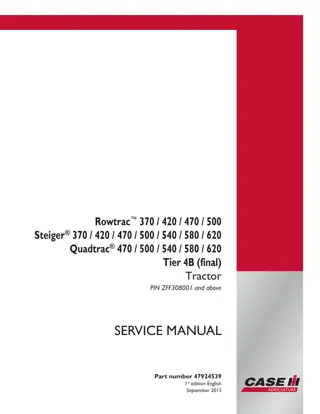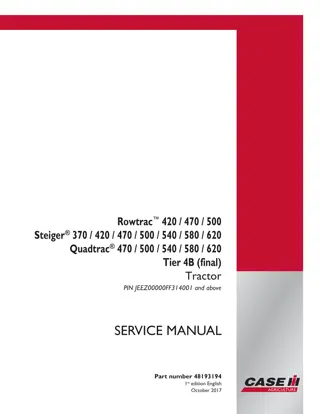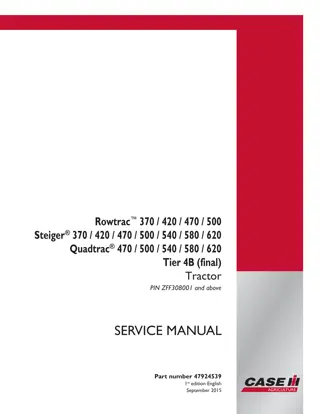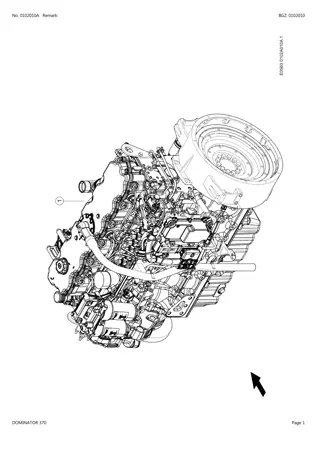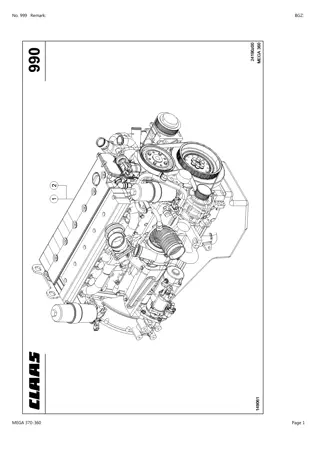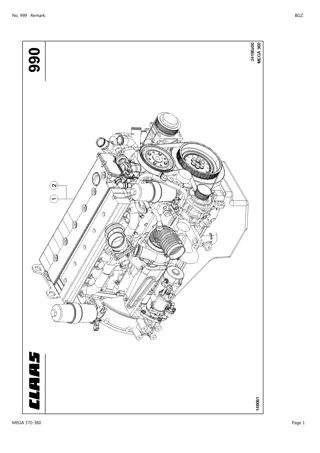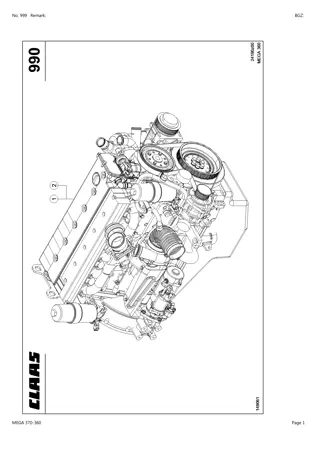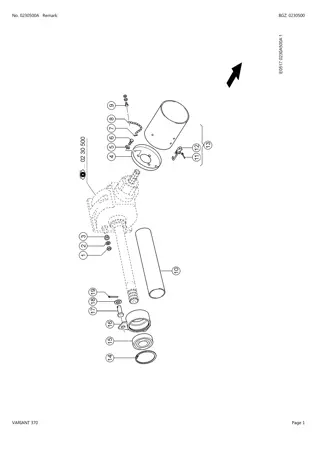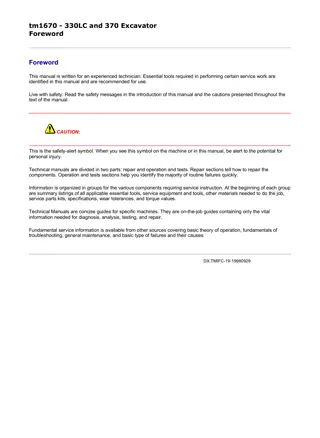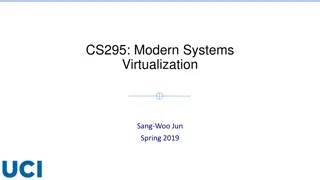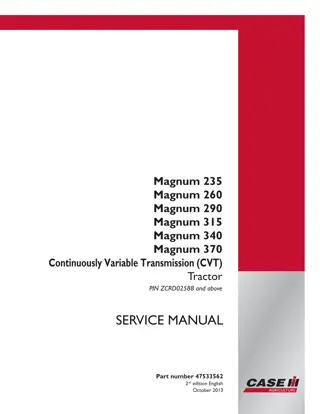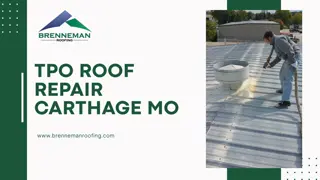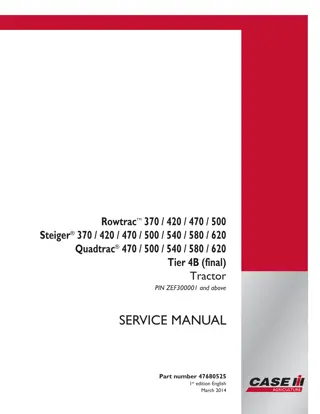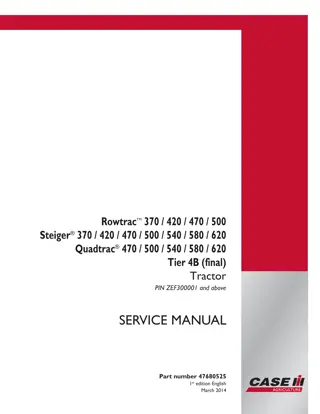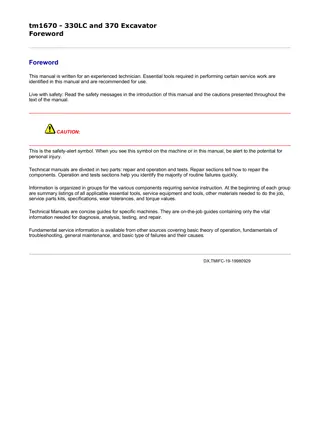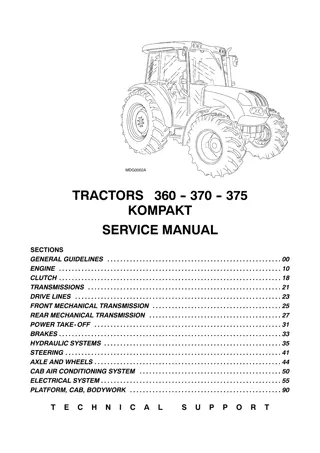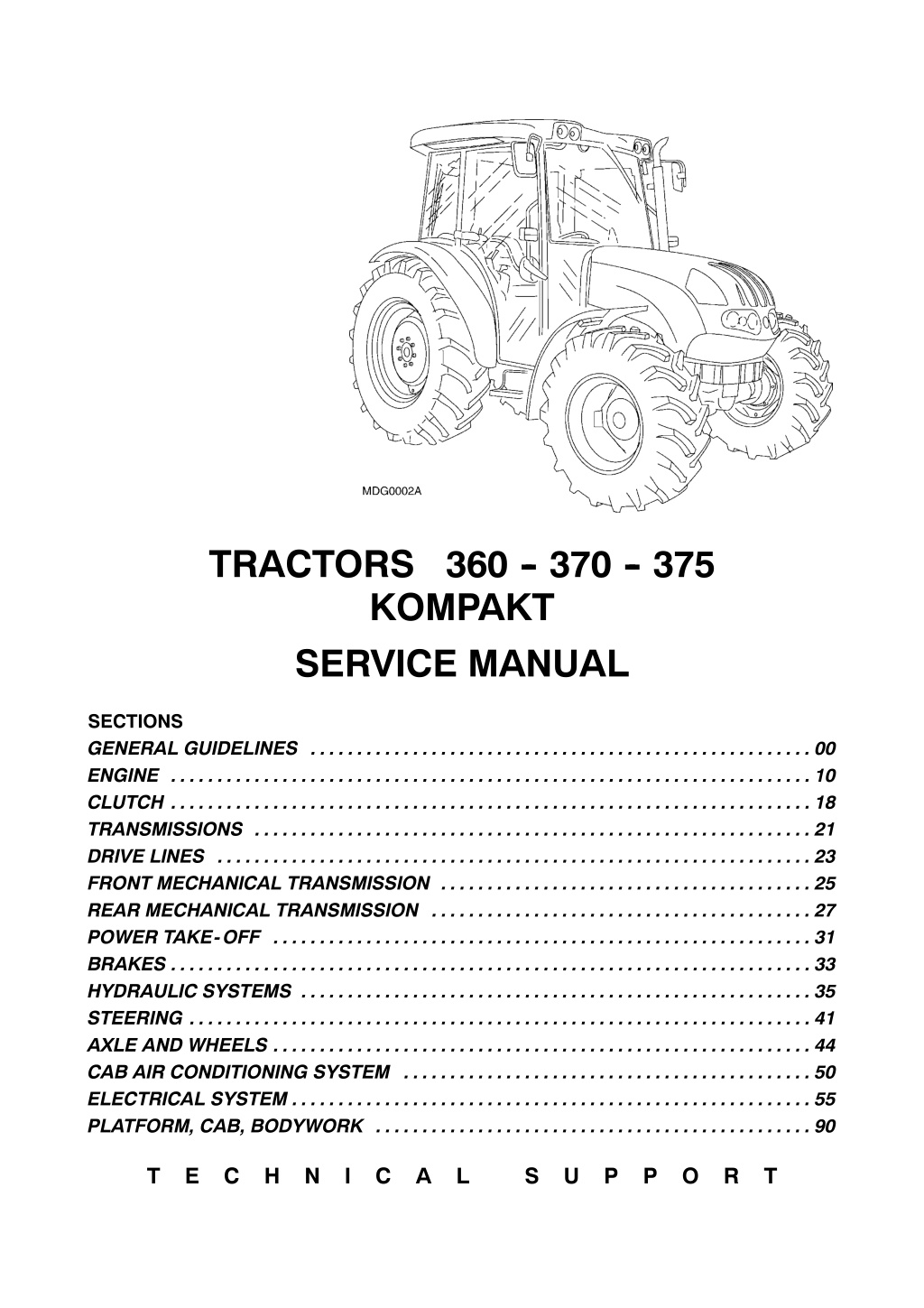
STEYR 370 KOMPAKT Tractor Service Repair Manual Instant Download
Please open the website below to get the complete manualnn//
Download Presentation

Please find below an Image/Link to download the presentation.
The content on the website is provided AS IS for your information and personal use only. It may not be sold, licensed, or shared on other websites without obtaining consent from the author. Download presentation by click this link. If you encounter any issues during the download, it is possible that the publisher has removed the file from their server.
E N D
Presentation Transcript
TRACTORS 360 - - 370 - - 375 KOMPAKT SERVICE MANUAL SECTIONS GENERAL GUIDELINES ENGINE . . . . . . . . . . . . . . . . . . . . . . . . . . . . . . . . . . . . . . . . . . . . . . . . . . . . . . . . . . . . . . . . . . . . . CLUTCH . . . . . . . . . . . . . . . . . . . . . . . . . . . . . . . . . . . . . . . . . . . . . . . . . . . . . . . . . . . . . . . . . . . . . TRANSMISSIONS . . . . . . . . . . . . . . . . . . . . . . . . . . . . . . . . . . . . . . . . . . . . . . . . . . . . . . . . . . . . DRIVE LINES . . . . . . . . . . . . . . . . . . . . . . . . . . . . . . . . . . . . . . . . . . . . . . . . . . . . . . . . . . . . . . . . FRONT MECHANICAL TRANSMISSION . . . . . . . . . . . . . . . . . . . . . . . . . . . . . . . . . . . . . . . . REAR MECHANICAL TRANSMISSION . . . . . . . . . . . . . . . . . . . . . . . . . . . . . . . . . . . . . . . . . POWER TAKE-OFF . . . . . . . . . . . . . . . . . . . . . . . . . . . . . . . . . . . . . . . . . . . . . . . . . . . . . . . . . . BRAKES . . . . . . . . . . . . . . . . . . . . . . . . . . . . . . . . . . . . . . . . . . . . . . . . . . . . . . . . . . . . . . . . . . . . . HYDRAULIC SYSTEMS . . . . . . . . . . . . . . . . . . . . . . . . . . . . . . . . . . . . . . . . . . . . . . . . . . . . . . . STEERING . . . . . . . . . . . . . . . . . . . . . . . . . . . . . . . . . . . . . . . . . . . . . . . . . . . . . . . . . . . . . . . . . . . AXLE AND WHEELS . . . . . . . . . . . . . . . . . . . . . . . . . . . . . . . . . . . . . . . . . . . . . . . . . . . . . . . . . . CAB AIR CONDITIONING SYSTEM . . . . . . . . . . . . . . . . . . . . . . . . . . . . . . . . . . . . . . . . . . . . ELECTRICAL SYSTEM . . . . . . . . . . . . . . . . . . . . . . . . . . . . . . . . . . . . . . . . . . . . . . . . . . . . . . . . PLATFORM, CAB, BODYWORK . . . . . . . . . . . . . . . . . . . . . . . . . . . . . . . . . . . . . . . . . . . . . . . . . . . . . . . . . . . . . . . . . . . . . . . . . . . . . . . . . . . . . . . . . . . . . . . . . . . . . 00 10 18 21 23 25 27 31 33 35 41 44 50 55 90 T E C H N I C A L S U P P O R T
SECTION 00 - - GENERAL GUIDELINES - - CHAPTER 1 3 SAFETY REGULATIONS PAY ATTENTION TO THIS SYMBOL This warning symbol points out important messages concerning your safety. Carefully read the following safety regulations and observeadvisedprecautionsin orderto avoidpoten- tial hazards and safeguard your health and safety. In this manual the symbol is accompanied by the fol- lowing key- -words: CAUTION - - Warnings concerning unsuitable repair operations that may jeopardise the safety of Service personnel. DANGER - - It gives specific warning about potential dangers for personal safety of the operator or other persons directly or indirectly involved in the oper- ation. 1 -- Do not carry out repair operations with someone sitting in the driver s seat, unless the person is a trained technician who is assisting with the oper- ation in question. ACCIDENT PREVENTION Most accidents or injuries that occur in workshops are the result of non--observance of simple and fun- damental safety regulations. For this reason, IN MOST CASES THESE ACCIDENTS CAN BE AVOIDEDbyforeseeingpossiblecausesandconse- quently acting with the necessary caution and care. Accidentsmayoccurwithalltypesofvehicle,regard- less of how well it was designed and built. A careful and judicious service technician is the best guarantee against accidents. Precise observance of the most basic safety rule is normally sufficient to avoid many serious accidents. DANGER. Never carry out any cleaning, lubrication or maintenance operations when the engine is run- ning. -- Do not operate the vehicle or use any of the im- plements from different positions, other than the driver s seat. -- Do not carry out operations on the vehicle with the engine running,unless specificallyindicated. -- Stop the engine and check that the hydraulic cir- cuits are pressure--free before removing caps, covers, valves, etc. -- All repair and maintenance operations must be carried out using extreme care and attention. -- Service stairs and platforms used in a workshop or in the field should be built in compliance with the safety rules in force. -- Disconnect the batteries and label all controls to indicate that the vehicle is being serviced. Any partsthataretoberaisedmustbelockedinposi- tion. SAFETY REGULATIONS GENERAL -- Do not check or fill fuel tanks, accumulator bat- teries, nor use starting liquid when smoking or near naked flames, as these fluids are inflam- mable. -- Carefully follow specified repair and mainten- ance procedures. -- Do not wear rings, wristwatches, jewellery, un- buttoned or loose articles of clothing such as: ties,tornclothing,scarves,openjacketsorshirts with open zips that may remain entangled in moving parts. It is advised to wear approved safety clothing, e.g.: non--slip footwear, gloves, safety goggles, helmets, etc. -- Brakes are inoperative when manually released for repair or maintenance purposes. Use blocks orsimilardevices tocontrol themachine inthese conditions. -- The fuel nozzle should always be in contact with the filling aperture. Maintain thisposition untilfill- ing operations are completed in order to avoid possible sparks caused by the accumulation of static electricity. 6-84310 - - 07 - - 2004
SECTION 00 - - GENERAL GUIDELINES - - CHAPTER 1 4 -- Only use specified towing points for towing the tractor. Connect parts carefully. Make sure that all pins and/or locks are secured in position be- fore applying traction. Never remain near the towing bars, cables or chains that are operating under load. -- When carrying out checks with the engine run- ning,requesttheassistanceofanoperatorinthe driver s seat. The operator must maintain visual contact with the service technician at all times. -- If operating outside the workshop, position the vehicle on a flat surface and lock in position. If working on a slope, lock the vehicle in position. Move to a flat area as soon as is safely possible. -- Transport vehicles that cannot be driven using a trailer or a low--loading platform trolley, if avail- able. -- Damagedorbentchainsorcablesareunreliable. Do not use them for lifting or towing. Always use suitable protective gloves when handling chains or cables. -- When loading or unloading the vehicle from the trailer (or other means of transport), select a flat area capable of sustaining the trailer or truck wheels. Firmly secure the tractor to the truck or trailerandlockthewheelsintheposition usedby the carrier. -- Chains should always be safely secured. Make surethatthehitch--uppointiscapableofsustain- ing the load in question. Keep the area near the hitch--up point, chains or cables free of all by- standers. -- Electric heaters, battery--chargers and similar equipment must only be powered by auxiliary power supplies with efficient ground insulationto avoid electrical shock hazards. -- Maintenance and repair operations must be car- riedoutinaCLEANandDRYarea.Eliminateany water or oil spillage immediately. -- Always use suitable hoisting or lifting devices when raising or moving heavy parts. -- Do not create piles of oil or grease--soaked rags as they represent a serious fire hazard. Always place them into a metal container. Before starting the tractor or its attachments, check, adjust andblock theoperator s seat.Also checkthattherearenopersonswithinthetractor or implement range of action. -- Take extra care if bystanders are present. -- Never pour petrol or diesel oil into open, wide or low containers. -- Never use petrol, diesel oil or other inflammable liquids as cleaning agents. Use non--inflam- mable, non toxic commercially available sol- vents. -- Do not keep into your pockets any object which might fall unobserved into the Vehicle s inner compartments. -- Wear safety goggles with side guards when cleaning parts with compressed air. -- In the presence of protruding metal parts, use protective goggles or goggles with side guards, helmets, special footwear and gloves. -- Limit the air pressure to a maximum of 30.45 psi (2.1 bar), according to local regulations. -- When welding, use protective safety devices: tinted safety goggles, helmets, special overalls, gloves and footwear. All persons present in the area where welding is taking place must wear tinted goggles. NEVER LOOK DIRECTLY AT THE WELDING ARC WITHOUT SUITABLE EYE PROTECTION. -- Do notrun theengine inconfined spaceswithout suitable ventilation. -- Do not smoke, use naked flames, or cause sparks in the area when fuel filling or handling highly inflammable liquids. -- Metal cables tend to fray with repeated use. Al- ways use suitable protective devices (gloves, goggles, etc.) when handling cables. -- Never use naked flames for lighting when work- ing on the machine or checking for leaks . -- All movements must be carried out carefully when working under, on or near the vehicle. Wear protective equipment: helmets, goggles and special footwear. -- Handle all parts carefully. Do not put your hands or fingers between moving parts. Always wear suitable safety clothing -- safety goggles, gloves and shoes. 6-84310 - - 07 - - 2004
https://www.ebooklibonline.com Hello dear friend! Thank you very much for reading. Enter the link into your browser. The full manual is available for immediate download. https://www.ebooklibonline.com
SECTION 00 - - GENERAL GUIDELINES - - CHAPTER 1 5 START UP -- Never run the engine in confinedspaces thatare not equipped with adequate ventilation for ex- haust gas extraction. enough to penetrate the skin; therefore, NEVER USE HANDS TO CHECK FOR LEAKS. Use a piece of cardboard or wood for this purpose. If any liquid penetrates skin tissue, call for medical aid immediately. Failure to treat this condition withcorrectmedicalproceduremayresultinseri- ous infection or dermatosis. -- Never bring your head, body, arms, legs, feet, hands, fingers near fans or rotating belts. -- In order to check the pressure in the system use suitable instruments. ENGINE -- Always loosen the radiator cap slowly before re- moving it to allow any remaining pressure in the system to be discharged. Filling up with coolant should only be carried out with the engine stopped or idling (if hot). WHEELS AND TYRES -- Check that the tyres are correctly inflated at the pressure specified by the manufacturer. Periodically check for possible damage to the rims and tyres. -- Neverfill upwith fuelwhen theengine isrunning, especially if hot, in order to prevent the outbreak of fire as a result of fuel spillage. -- Stand away from (at the side of) the tyre when checking inflation pressure. -- Never check or adjust fan belt tension when the engine is running. Neveradjustthefuelinjectionpumpwhentheve- hicle is moving. -- Only check pressure when the tractor is un- loaded and the tyres are cold, to avoid incorrect readings as a result of over--pressure. Do not reuse parts of recovered wheels as improper welding, brazing or heating may weaken the wheel and make it fail. -- Never lubricate the vehicle when the engine is running. -- Never cut or weld a rim mounted with an inflated tyre. ELECTRICAL SYSTEMS -- If it is necessary to use auxiliary batteries, re- member that both ends of the cables must be connectedasfollows:(+)with(+)and(--)with(--). Avoid short--circuiting the terminals. GAS RE- LEASED FROM BATTERIES IS HIGHLY IN- FLAMMABLE. During charging, leave the bat- tery compartment ventilation.Nevercheckthebatterychargeusing jumpers (metal objects placed on the ter- minals). Avoid sparks or flames near the battery zone. Do no smoke to prevent explosion haz- ards. -- To remove the wheels, lock both the front and rear vehicle wheels. After having raised the ve- hicle,positionsupportsunderneath,accordingto regulations in force. uncovered to improve -- Deflate the tyre before removing any object caught in the tyre tread. -- Never inflate tyres using inflammable gases; as this may result in explosions and injury to by- standers. -- Before servicing operations, check for fuel or current leaks. Eliminate any eventual leaks be- fore proceeding with work. REMOVAL AND INSTALLATION -- Lift and handle all heavy parts using suitable ho- isting equipment. Ensure that parts are sup- ported by appropriate slings and hooks. Use lift- ing eyes provided to this purpose. Extra care should be taken if persons are present near the load to be lifted. -- Neverchargebatteriesinconfinedspaces.Make sure that there is adequate ventilation in order to prevent accidental explosion hazards as a result of the accumulation of gases released during charging operations. -- Handle all parts carefully. Do not put your hands or fingers between parts. Wear suitable safety clothing -- safety goggles, gloves and shoes. -- Always disconnect the batteries before perform- inganykindofservicingontheelectricalsystem. -- Avoid twisting chains or metal cables. Always wear safety gloves when handling cables or chains. HYDRAULIC SYSTEMS -- A liquid leaking from a tiny hole may be almost invisible but, at the same time, be powerful 6-84310 - - 07 - - 2004
SECTION 10 - - ENGINE - - CHAPTER 1 1 SECTION 10 - - ENGINE Chapter 1 - - Engine CONTENT Section Description Page General specifications Main data . . . . . . . . . . . . . . . . . . . . . . . . . . . . . . . . . . . . . . . . . . . . . . . . . . . . . . . . . . . . . . . . . . . . . . . . . . . . . . . . . . . . . . . . . . . . . . . . . . . . . . . . . . . . . . . . . . . . . . . . . . . . . 2 5 10 000 Torque settings Tools . . . . . . . . . . . . . . . . . . . . . . . . . . . . . . . . . . . . . . . . . . . . . . . . . . . . . . . . . . . . . . . . . . . . . . . Sections . . . . . . . . . . . . . . . . . . . . . . . . . . . . . . . . . . . . . . . . . . . . . . . . . . . . . . . . . . . . . . . . . . . . Lubrication and cooling system diagrams . . . . . . . . . . . . . . . . . . . . . . . . . . . . . . . . . . . . . . . . Troubleshooting . . . . . . . . . . . . . . . . . . . . . . . . . . . . . . . . . . . . . . . . . . . . . . . . . . . . . . . . . . . . . . Engine. Removal -- Installation . . . . . . . . . . . . . . . . . . . . . . . . . . . . . . . . . . . . . . . . . . . . . . . . . Compression test . . . . . . . . . . . . . . . . . . . . . . . . . . . . . . . . . . . . . . . . . . . . . . . . . . . . . . . . . . . . Engine. Disassembly -- Assembly . . . . . . . . . . . . . . . . . . . . . . . . . . . . . . . . . . . . . . . . . . . . . . Valve guides. Replacement . . . . . . . . . . . . . . . . . . . . . . . . . . . . . . . . . . . . . . . . . . . . . . . . . . . . Injector sleeve. Replacement . . . . . . . . . . . . . . . . . . . . . . . . . . . . . . . . . . . . . . . . . . . . . . . . . . Front engine oil seal. Removal -- Installation Valve rocker arm clearance adjustment . . . . . . . . . . . . . . . . . . . . . . . . . . . . . . . . . . . . . . . . . Engine injector. Removal -- Installation . . . . . . . . . . . . . . . . . . . . . . . . . . . . . . . . . . . . . . . . . . Bosch injection pump. Removal--Installation timing and air bleeding check Exhaust pipe. Removal--Refitting . . . . . . . . . . . . . . . . . . . . . . . . . . . . . . . . . . . . . . . . . . . . . . . Coolant pump. Removal--Refitting with radiator removed Coolant pump. Overhaul . . . . . . . . . . . . . . . . . . . . . . . . . . . . . . . . . . . . . . . . . . . . . . . . . . . . . . Thermostat valve. Removal--Refitting . . . . . . . . . . . . . . . . . . . . . . . . . . . . . . . . . . . . . . . . . . . Radiator. Removal -- Installation . . . . . . . . . . . . . . . . . . . . . . . . . . . . . . . . . . . . . . . . . . . . . . . . . . . . . . . . . . . . . . . . . . . . . . . . . . . . . . . . . . . . . . . . . . . . . . . . . . . . . . . . . . . . . . 20 21 23 25 27 31 33 34 69 72 74 76 78 80 86 87 88 89 91 10 001 10 10 001 30 10 001 54 10 101 53 10 101 60 10 102 70 10 106 12 10 218 30 10 246 14 10 254 44 10 402 11 10 402 28 10 402 30 10 406 10 . . . . . . . . . . . . . . . . . . . . . . . . . . . . . . . . . . . . . . . . . . . . . . . . . . . . . . . . . . . . . . . . . . . . . . . . . . 6-84310 - - 07 - - 2004
SECTION 10 - - ENGINE - - CHAPTER 1 2 GENERAL SPECIFICATIONS Engine, technical type: -- Mod. 360 -- type 8035.05C.615/619/919 (BOSCH pump) See data on page 6--7 -- Mod. 370 -- type 8035.25R.615/619/919 (BOSCH pump) See data on page 8--9 -- Mod. 375 -- type 8035.25.615/619/919 (BOSCH pump) See data on page 10--11 Cycle . . . . . . . . . . . . . . . . . . . . . . . . . . . . . . . . . . . . . . . . . . . . . . . . . . . . . . . . . . . . . . . diesel, 4--stroke Fuel injection . . . . . . . . . . . . . . . . . . . . . . . . . . . . . . . . . . . . . . . . . . . . . . . . . . . . . . . . Direct Number of cylinders in line . . . . . . . . . . . . . . . . . . . . . . . . . . . . . . . . . . . . . . . . . . . . . 3 Cylinder liners . . . . . . . . . . . . . . . . . . . . . . . . . . . . . . . . . . . . . . . . . . . . . . . . . . . . . . . in cylinder block Diameter of pistons -- Mod. 360 . . . . . . . . . . . . . . . . . . . . . . . . . . . . . . . . . . . . . . . . . . . . . . . . . . . . . . . . 4.0944 in. (104 mm) -- Mod. 370 . . . . . . . . . . . . . . . . . . . . . . . . . . . . . . . . . . . . . . . . . . . . . . . . . . . . . . . . 4.0944 in. (104 mm) -- Mod. 375 . . . . . . . . . . . . . . . . . . . . . . . . . . . . . . . . . . . . . . . . . . . . . . . . . . . . . . . . 4.0944 in. (104 mm) Piston stroke . . . . . . . . . . . . . . . . . . . . . . . . . . . . . . . . . . . . . . . . . . . . . . . . . . . . . . . . 4.5275 in. (115 mm) Total displacement: 2931 cm3 -- Mod. 360 . . . . . . . . . . . . . . . . . . . . . . . . . . . . . . . . . . . . . . . . . . . . . . . . . . . . . . . . 2931 cm3 -- Mod. 370 . . . . . . . . . . . . . . . . . . . . . . . . . . . . . . . . . . . . . . . . . . . . . . . . . . . . . . . . 2931 cm3 -- Mod. 375 . . . . . . . . . . . . . . . . . . . . . . . . . . . . . . . . . . . . . . . . . . . . . . . . . . . . . . . . Compression ratio mod. 360 . . . . . . . . . . . . . . . . . . . . . . . . . . . . . . . . . . . . . . . . . . . 17:1 normally aspirated Compression ratio for Mod. 370 and 375 . . . . . . . . . . . . . . . . . . . . . . . . . . . . . . . . 16.5:1 turbocharged Maximum power: -- Mod. 360 . . . . . . . . . . . . . . . . . . . . . . . . . . . . . . . . . . . . . . . . . . . . . . . . . . . . . . . . 43.5 kW (59 Hp) -- Mod. 370 . . . . . . . . . . . . . . . . . . . . . . . . . . . . . . . . . . . . . . . . . . . . . . . . . . . . . . . . 53 kW (72 HP) -- Mod. 375 . . . . . . . . . . . . . . . . . . . . . . . . . . . . . . . . . . . . . . . . . . . . . . . . . . . . . . . . 55.5 kW (76 Hp) Maximum power speed . . . . . . . . . . . . . . . . . . . . . . . . . . . . . . . . . . . . . . . . . . . . . . . 2300 rpm Maximum torque speed for Mod. 360 . . . . . . . . . . . . . . . . . . . . . . . . . . . . . . . . . . . 1400 rev/min Maximum torque speed for Mod. 370 . . . . . . . . . . . . . . . . . . . . . . . . . . . . . . . . . . . 1400 rev/min Maximum torque speed for Mod. 375 . . . . . . . . . . . . . . . . . . . . . . . . . . . . . . . . . . . 1400 rev/min Number of main bearings . . . . . . . . . . . . . . . . . . . . . . . . . . . . . . . . . . . . . . . . . . . . . . 4 Sump . . . . . . . . . . . . . . . . . . . . . . . . . . . . . . . . . . . . . . . . . . . . . . . . . . . . . . . . . . . . . . . structural, cast iron (continued) 6-84310 - - 07 - - 2004
SECTION 10 - - ENGINE - - CHAPTER 1 23 1 2 7 6 5 4 3 25355 3 Longitudinal section of engine (mod. 360). 6-84310 - - 07 - - 2004
SECTION 10 - - ENGINE - - CHAPTER 1 24 25356 4 Cross- -section of engine (mod. 360). 6-84310 - - 07 - - 2004
SECTION 10 - - ENGINE - - CHAPTER 1 25 5 1 2 3 4 5 6 7 8 1. Oil filler cap -- 2. Filter safety valve (opens when oil pressure at filter inlet exceeds the outlet pressure by 1.5--1.7 bar/cm2) -- 3. Filter -- 4. Engine lubrication oil low pressure indicator lamp switch (located on the dashboard) -- 5. Dipstick -- 6. Pump -- 7. Oil pressure limiting valve -- 8. Mesh filter on intake 5335B Engine lubrication system diagram 1 3 5335A 6 8 6-84310 - - 07 - - 2004
SECTION 10 - - ENGINE - - CHAPTER 1 26 b a 1 2 3 4 25363 6 5 6 Engine cooling system circuit diagram. A. Coolant circulation with thermostat valve closed B. Coolant circulation with thermostat valve open 1. Thermostat 2. Pump Electric thermometer for engine coolant temperature Temperature transmitter Fan Radiator 3. 4. 5. 6. 6-84310 - - 07 - - 2004
SECTION 10 - - ENGINE - - CHAPTER 1 31 Op. 10 001 10 ENGINE Removal- -Installation DANGER Lift and handle all heavy parts using suitable lifting equipment. Makesurethatassembliesorpartsare supportedby means of suitable slings and hooks. Check that no one is in the vicinity of the load to be lifted. WARNING Use suitable tools to align the holes. NEVER USE FINGERS OR HANDS. Proceed as follows. 1. Carry out operation 18 110 10 Clutch, only re- moval (see Sect. 18). 2. Disconnect the clogged air filter sensor connec- tion (1). 27764 7 3. Disconnect the audible warning connection (1). 27765 8 4. Unscrew the clamps 1, 2 and 3 and remove the inlet sleeve. 27180 9 6-84310 - - 07 - - 2004
SECTION 10 - - ENGINE - - CHAPTER 1 32 5. Unscrew the relative clamps and detach the upper (2) and lower sleeves on the radiator, re- move the radiator bracket (1). 27807 10 6. Position two fixed stands under the axle support andundertheengine,positionachainsothatthe engine is balanced whilst being raised and insert two wooden blocks between the support and the axle to prevent swinging. 7. Unscrewthebolts(1)fasteningthesupporttothe front axle. 8. Detach the engine from the axle -- support unit. 9. To re--fit the engine, proceed as follows. 27808 11 WARNING Use suitable tools to align the holes. NEVER USE FINGERS OR HANDS. -- Apply the torque settings listed on page 20. -- Re--fit thefront axlesupport assemblyon theen- gine. -- Connectandsecuretheupperandlowersleeves on the radiator and the connecting bracket. -- Fit and secure the inlet sleeve. -- Connect the audible warning and clogged air filter indicator connections. -- Carry out operation 18 110 10 Clutch, only in- stallation (see Sect. 18). 6-84310 - - 07 - - 2004
SECTION 10 - - ENGINE - - CHAPTER 1 33 Op. 10 001 30 COMPRESSION TEST In case of poor engine performance, in addition to checking the fuel injection system (injection nozzles and injection pump), also test the compression on each cylinder. DANGER Do not use matches, lighters, blowtorches or any form of naked flame as a source of light when in- specting the engine due to the presence of flam- mable fluids and vapour. 6) fit the dummy injector 380000617 in place of the injector removed previously, inserting the copper sealing washer; 7) connect the compression 380000303 and take readings while turning the en- gine over with the starter motor. On engines in perfect working order, with the sump oil at approx. 104 F (40 C) at sea level (2992 in. (760 mm) mercury) and at anengine speedof 200to 280 rpm, the compression should be 1.75 to 1.89psi (25.5 to 27.5 bar). 8) Test the compression on the other cylinders, re- peating steps 4--5--6--7, bearing in mind that: The minimum permissible compression on a used engine is 1.48 psi (21.6 bar). The maximum permissible compression difference between cylinders is 0.20 psi (3 bar). Every 100 metres above sea level corresponds to a reduction in compression by approx. 1%. test instrument Degree of compression The compression ratio is a measure of the quantity of air drawn into the cylinder, andprovides anindica- tion of the efficiency of the sealing elements in the cylinder (piston rings and valves). Uniformcompressioninallthecylindersensuresthat they all perform an equal amount of work, provided that each cylinder is injected with the same quantity of fuel at the right time. Low compression not only reduces engine perform- ance, it also causes incomplete fuel combustion due to the lack of available combustion air. The engine therefore gives poor performance with excessive fuel consumption and, consequently, ex- haust smoke and restriction of the exhaust pass- ages. As the compression ratio also varies with the tem- peratureoftheengine(coldenginesproducelower compressionvaluesthanhotengines),thecompres- sion should only be tested when the engine is at nor- mal operating temperature. Compression should be tested using the compres- sion test kit 380000303, as follows: 1) run the engine until it reaches normal operating temperature; 2) switch off the engine; 3) disconnect the lead from the engine stop electro- magnet on the injection pump in order to close the valve and block the flow of fuel to the injectors; 4) remove the injector from the cylinder to be tested; 5) turn the engine over a few times with the starter motor in order to expel any carbon residue; CONSIDERATIONS: Uniform compression Although high compression is important, it is more important for smooth engine running that compres- sion is uniform in all cylinders. Low compression readings. If extremely low pressure readings are obtained on one cylinder it is advisable to repeat the test. Before testing this time, pour about a spoonful of en- gine oil into the cylinder through the injector bore. Turn over the engine a few times to distribute the oil evenly over the cylinder walls, and then repeat the test. If the second test readings are significantly higher, suspectwornpistonrings,out--of--roundordamaged pistons or liners. If the second test readings are not higher, the prob- lem will be the valves. On the other hand, if the second test reading shows only a slight improvement, the problem will be due to both the valves and the rings. 6-84310 - - 07 - - 2004
SECTION 10 - - ENGINE - - CHAPTER 1 34 Op. 10 001 54 ENGINE Disassembly - - Assembly WARNING Handle all parts carefully. Do not put your hands or fingers between parts. Wear the prescribed safety clothing, including goggles, gloves and safety foot- wear. Proceed as follows. 1. Unscrew the thermostarter union (2), the fittings fastening the pipes (1) for delivery to the pump and the injectors and detach these pipes (1). 27770 12 2. Unscrewtheinjectionpumpconnectionpipes(2) and the bolts fastening the support (1), remove the support with the fuel filter. 27771 13 3. Unscrew;thehydraulicpumppiperetainingbolts (2), bolts (1) retaining the oil filter, comprehen- sive of the support, to the engine and remove it. 27772 14 4. Unscrew the retaining bolts and remove the hy- draulic pumps of the lift (2) and services (1), the latter comprehensive of piping (3). 27773 15 6-84310 - - 07 - - 2004
SECTION 10 - - ENGINE - - CHAPTER 1 35 5. Unscrew the retaining bolts and remove the starter motor (1). 27774 16 6. Unscrew the retaining bolts and take off the cover(3),unscrewthenut(2)fasteningtheinjec- tion pump (1) and remove this from the opposite side. 27775 17 7. Unscrew the retaining nuts and remove the fuel pump (1). 27776 18 8. Unscrew the retaining bolts and remove the ex- haust silencer (1) comprehensive of the vertical pipe. On the version with a horizontal exhaust pipe, this must be removed when removing the engine. 27777 19 6-84310 - - 07 - - 2004
SECTION 10 - - ENGINE - - CHAPTER 1 36 9. Unscrew the retaining bolts, remove the alterna- tor (1) and recover the drive belt. 10. Unscrew the engine oil filter (2). 27778 20 11. Unscrew the retaining bolts and remove the ex- haust manifold (1). 27779 21 12. Unscrew the retaining bolts and remove the pipe (1) from the water pump. 27780 22 13. Unscrewtheretainingboltsandremovethecool- ant pump (1) together with the fan (2). 27781 23 6-84310 - - 07 - - 2004
SECTION 10 - - ENGINE - - CHAPTER 1 37 14. Unscrewtheretainingboltsandremovethecool- ant pump support (1). 27782 24 15. Unscrewtheretainingboltsandremovethether- mostat valve unit (2) together with the bracket (1). 27783 25 16. Unscrew the retaining bolts and remove the in- take manifold (1). 27784 26 17. Remove the injector mounting nuts, the underly- ing spherical washers,then thesupports andthe injectors themselves. 18. Remove the retaining bolts (1), washers and seal, then remove the rocker housing cover (2) and seal. 1 2 25098 27 6-84310 - - 07 - - 2004
SECTION 10 - - ENGINE - - CHAPTER 1 38 19. Remove the rocker shaft retaining bolts (2), then remove the entire rocker shaft assembly (1). 1 2 25099 28 20. Remove the valve collets (1) and extract the pushrods (2). 2 1 25100 29 21. Unscrew the cylinder head bolts (1) and remove the head using a hoist and lifting hook 380000216. 22. Remove the cylinder head gasket. 1 25101 30 23. Unscrewthesumppanretainingbolts(4) andre- move the sump pan using a hoist, lifting hook 380000216 and lifting chain with eyeholes. 24. Remove the half--gaskets (1) and (3) between the crankcase/sump pan and the gasket (2) be- tween the timing gear carrier/sump pan. 1 2 4 3 25104 31 6-84310 - - 07 - - 2004
SECTION 10 - - ENGINE - - CHAPTER 1 39 25. Remove the gasket (1) between the flywheel carrier and the sump pan. NOTE: When relocating gaskets (1) and (2, fig. 31), apply RHODORSIL CAF1 silicone sealing com- pound to the mating surfaces. 1 25105 32 26. Remove the rotating counterweight oil seal O-- ring (1) installed on the crankcase mating sur- face. 1 25106 33 27. Unscrew the retaining bolts (1) and remove the complete oil pump. 1 25107 34 28. Unscrew the retaining bolts (2) and remove the fan--alternator drive pulley (1). 1 2 25108 35 6-84310 - - 07 - - 2004
SECTION 10 - - ENGINE - - CHAPTER 1 40 29. Straighten the lock tab and remove the nut (1), securing the crankshaft against rotation. 1 25109 36 30. Pull the pulley hub off the crankshaft using tool 380000226 (1) and recover the Woodruff key. 1 25110 37 31. Unscrew the retaining bolts (1) and remove the timing cover and gasket. 1 25111 38 32. Unscrew the retaining bolts and remove the lift pump drive gear carrier (1). 1 25112 39 6-84310 - - 07 - - 2004
SECTION 10 - - ENGINE - - CHAPTER 1 41 33. Remove the circlip (1) and recover the thrust washer and the intermediate gear (2): 2 1 NOTE: When refitting the intermediate gear see en- gine timing instructions on page 49. 25113 40 34. Unscrew the retaining bolts (1) and remove the intermediate gear journal. 1 25114 41 35. Unscrew the retaining bolts (2) and withdraw the camshaft(3)completewiththecamshaftgear(1) and the end plate (4). 1 2 3 4 25115 42 36. Removethecirclip(1)andthethrustwasher,and withdraw the gear with fuel supply pump cam- shaft (2) from the opposite side. NOTE: This gear transmits drive to the injection pump gear. On re- -assembly, see the timing instruc- tions on page 49. 1 2 25108 43 6-84310 - - 07 - - 2004
SECTION 10 - - ENGINE - - CHAPTER 1 42 37. Unscrew the retaining bolts (1) and remove the timing gear case. 1 25109 44 38. Replace the O--ring seal (1) installed in the lift pump drive shaft lubrication line. 39. Remove the crankcase -- timing gear case gasket. 1 25118 45 40. Rotate the engine through 90_, take out the re- tainingbolts(2)andrecoverthebig--endcaps(1) with their bearings. 1 2 25119 46 41. Slide the pistons (1), complete with rings, gudg- eon pins and connecting rods, out of the cylinder linings. 1 25108 47 6-84310 - - 07 - - 2004
SECTION 10 - - ENGINE - - CHAPTER 1 43 42. Rotatetheengineonthe standthrough 90_back to the horizontal position. Unscrew the flywheel bolts and remove the flywheel with the aid of a hoist and hook 380000216. 43. Unscrew the retaining bolts and remove the rear cover (1) complete with gasket. 1 25109 48 44. Unscrew the main bearing cap bolts (1), and re- movethemainbearingcapswithrelativebearing shells, recover the thrust washerslocated onthe penultimate main bearing, as shownin thedraw- ing. 45. Lift the crankshaft clear of the crankcase using a hoist and nylon sling. Recover the bearing shells, thrust washers and tappets. 1 25122 49 46. Turn the engine through 180_ on rotating stand 380000301 (2). Attach the lifting chain with eye- holes to the crankcase, as shown in the figure. Slightly tension the chain with the hoist and the hook 380000216, take out the bolts securing the crankcase to the rotating stand (2) and bracket (3) of the 380000313 series. 47. Lift the engine clear of the stand. 48. Unscrew the retaining bolts and remove the rear crankcase housing (1) and its gasket. 1 2 3 25123 50 6-84310 - - 07 - - 2004
SECTION 10 - - ENGINE - - CHAPTER 1 44 GENERAL NOTES -- Afterdisassemblingtheengine,thoroughlyclean the parts. -- Engine assembly operations should be carried out in reverse order to the disassembly oper- ations described on pages 34 to 43. -- The following pages 44 to 50 concern assembly operations that require special attention in order to correctly fit parts. -- The torque settings are shown on page 20. REMEMBER THAT: -- When partially or fully disassembling the engine, all seals must be replaced. -- Beforeinsertingrotatingpartsandsealsinseats, lubricate the parts with engine oil. -- When fitting the oil filter, lubricate the seal with engine oil. WARNING Handle all parts carefully, do not put your hands or fingers between parts and use appropriate tools to align fixing holes. Wear the prescribed safety clothing, including goggles, gloves and safety footwear. MOUNTING THE TAPPETS AND DRIVE SHAFT WITH MAIN BEARING CAPS, BEARINGS AND THRUST RINGS: CHECK- ING AXIAL CLEARANCE OF DRIVE SHAFT (Disassembly operations 44 to 45) Proceed as follows: -- Install the tappets in their crankcase bores. -- Lubricate the main bearing seats with engine oil and install the half shell bearings (3). -- Insert washers (1), applying grease on the penultimate mainbearingshims(2)tofacilitatetheoperation. the crankshaft semi--circular thrust 1 3 2 25109 51 6-84310 - - 07 - - 2004
SECTION 10 - - ENGINE - - CHAPTER 1 45 -- Lubricate the uppersurfaces ofthe mainbearing shellswithengineoilandlowerthecrankshaft(1) into position, taking care not to dislodge the semi--circular thrust washers installed previous- ly. 1 24718 52 -- Lubricate the crankshaft journals with engine oil and fit the main bearing caps (3) with the half-- shells (4), fitting the top semi--circular thrust washers (2) to the penultimate bearing cap. Rotatethecrankshaft(1)afew timesto allowthe parts to settle into position. Insert the main bearing cap bolts and screw in until the head of the bolt is up against the cap. 1 2 3 -- -- 4 25108 53 -- Tighten all cap bolts (1) to a torque of 80 Nm (8.2 kgm). 1 24720 54 -- Using tool 380000304 (2) tighten each bolt (1) through a further 90 . 1 2 24744 55 6-84310 - - 07 - - 2004
SECTION 10 - - ENGINE - - CHAPTER 1 46 -- Check that the crankshaft endfloat does not ex- ceed the value specified on page 13. 24760 56 MOUNTING THE REAR COVER WITH SEAL AND ENGINE FLYWHEEL 1 (Disassembly operation 43) Proceed as follows: -- Fit the rear oil seal carrier (3) with the outer seal. Tightentheretainingbolts(2)tothetorquespeci- fied on page 20. Using a feeler gauge (1), check that the crankshaft flange is coaxial with the carrier. 3 2 24752 57 -- Fit theinner rearoil sealusing tool50139 (1)and hand grip. 1 24761 58 -- Fit the flywheel andtighten theretaining bolts(1) to a torque of 40 Nm (4.1 kgm). 1 24762 59 6-84310 - - 07 - - 2004
SECTION 10 - - ENGINE - - CHAPTER 1 47 -- Using tool 380000304 (1), tighten each flywheel bolt (2) through a further 60 . 1 2 24763 60 MOUNTING WITH RINGS, PINS, CONNECTING RODS, BIG END CAPS AND BEARINGS - - CHECK- ING PROTRUSION IN RELATION TO CYLIN- DER BLOCK FACE (Disassembly operations 40 and 41) Proceed as follows: -- Lubricate pistons, rings and cylinder liners with engine oil prior to fitting. -- Using piston ring pliers 380000221 fit the piston rings. Make sure that the piston ring gaps are offset at 180 . THE PISTONS COMPLETE 25163 61 -- Fit tool 380000220 (1) to insert the pistons (2) in the cylinder sleeves, taking care not to offset the gaps in the rings (described in the previous point. Insertthepiston/connectingrodintothecylinder liner, checking that the connecting rod number corresponds with the cylinder number and that the number stamped on the connecting rod is facing away from the camshaft. Fit the big--end caps (1), complete with shells, to the crankpins and tighten the cap bolts (2) to a torque of 40 Nm (4.1 kgm). -- 1 2 -- 25164 62 -- Using tool 380000304 (1), tighten each big--end cap bolt (2) through a further 60 . 1 2 25165 63 6-84310 - - 07 - - 2004
SECTION 10 - - ENGINE - - CHAPTER 1 48 -- Rotatetheengine onthe standthrough 180 and clean the upper face of the cylinder block. Bring the pistons (2), up to TDC and, using a dial gauge with a magnetic base (1), check that the piston (2) protrusion from the cylinder block face iswithinthetolerancelimitsspecifiedonpage13. 1 2 25166 64 SYNCHRONISING THE TIMING GEARS (Disassembly operations 32 to 36) Proceed as follows: -- Remove the cover of the flywheel housing in- spection window and its gasket. 25167 65 -- Rotate the crankshaft to bring cylinder no. 1 to TDC (compression stroke). Look through the inspection window to check that the notch in degrees aligns with the index mark, according to the type of BOSCH pump in- stalled on the tractor (see pages 6--8--10) with the indicator. 26107 66 -- Fitthetiminggears,makingsurethat thevarious reference marks on the gears are aligned. 25169 67 6-84310 - - 07 - - 2004
SECTION 10 - - ENGINE - - CHAPTER 1 49 REFITTING THE BOSCH INJECTION PUMP (Disassembly operation 6) -- Fit the BOSCH injection pump and proceed with the injection pump timing, as described on page 80. 1 25181 68 FITTING THE CYLINDER HEAD GASKET 1 (Disassembly operation 22) Proceed as follows: -- Before fitting the cylinder head, carefully clean and degrease the mating surface of the cylinder block. Locate the cylinder head gasket (1) with the word UP uppermost. 25173 69 FITTING AND TIGHTENING THE CYLINDER HEAD (Disassembly operation 21) Proceed as follows: -- Lowerthecylinderheadontotheblockandscrew in the cylinder head bolts (1, fig. 71) so that the heads are brought into contact with the cylinder head. -- Tightening sequence for cylinder head bolts (1, fig. 71) on 4--cylinder engines to be followed for tightening stages (A = fan end). 25174 70 -- Tighten the bolts (1) to a torque of 70 Nm (7.1 kgm) in the sequence indicated above (1ststage). Check the torque of all the bolts in the sequence indicated above (2ndstage). -- 1 25176 71 6-84310 - - 07 - - 2004
Suggest: If the above button click is invalid. Please download this document first, and then click the above link to download the complete manual. Thank you so much for reading
SECTION 10 - - ENGINE - - CHAPTER 1 50 -- Using tool 380000304 (1) tighten each bolt (2) in sequence through 90 (3rdphase) and then throughafurther90 (4thphase)in thesequence indicated above. 1 2 25177 72 ADJUSTING VALVE / ROCKER ARM CLEARANCE 1 (Disassembly operation 18) -- Before refitting the rocker cover, adjust thevalve clearances as described on pages 76 and 77. -- Tighten the rocker arm adjuster screw locknuts (1) to the torque specified on page 20. 25178 73 FITTING THE INJECTORS (Disassembly operation 17) Proceed as follows: -- Insert the injectors (2) in their respective bores. -- Position the injector support brackets and fit the spherical washers. -- Screw the bracket retaining nuts (1) up to the spherical washers then, using a torque wrench, tighten to the torque specified on page 20 in two stages : 1ststage, tighten nuts to 10 Nm (1 kgm), 2ndstage, tighten nuts to 25 Nm (2.6 kgm). -- Tighten the injector leak--off pipe union. -- Tighten the high--pressure fuel line union. 1 2 25179 74 ADJUSTING BELT TENSION ON THE COOLING SYSTEM (Disassembly operations 9) NOTE: Tension the belt correctly, as shown on page 68. 6-84310 - - 07 - - 2004
https://www.ebooklibonline.com Hello dear friend! Thank you very much for reading. Enter the link into your browser. The full manual is available for immediate download. https://www.ebooklibonline.com


